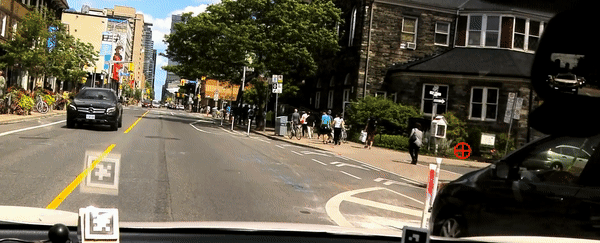When drivers navigate busy intersections, most of them fail to look out for pedestrians or cyclists when turning right, according to a new study.
In the summer, cars must share the road with more pedestrians and cyclists than usual, and in Toronto this is causing an epidemic of car accidents. By the start of June, the Canadian city had already experienced 21 fatalities between vehicles and pedestrians or vehicles and cyclists.
This isn't just something that Toronto is dealing with. Pedestrian and cyclist fatalities have been increasing all over the world, as infrastructure grows and cycling and driving become more popular.
In the Netherlands, where cycling is particularly common, more people died on a bike in 2017 than in a car.
"There are a lot of visual and mental demands on drivers at intersections, especially in a dense, urban environment like downtown Toronto," says lead author Nazli Kaya, a research assistant focused on understanding and improving human behaviour and performance.
"Drivers need to divide their attention in several directions, whether it's other vehicles, pedestrians or road signs and traffic signals - traffic safety instantly becomes a major concern," she added.
Kaya and her team set out to discover why these accidents are happening time and time again.
Their study is the first to track the eye movements of drivers when turning at busy intersections. Participants in the study were selected based on age and experience to rule out the "worst driving" scenarios.
Ultimately, the drivers chosen were between the ages of 35 and 54 and had more than three years of driving experience.
Before beginning, the participants were outfitted with eye-tracking equipment to accurately assess where they were looking. The drivers were then required to make several right turns at a variety of busy intersections, including a four-way stop and an uncontrolled T-intersection. At both intersections, there was a cycling lane running across the right-hand turn.
 (Nazli Kaya)
(Nazli Kaya)
The findings are both shocking and worrisome. The study found that before turning, 11 out of 19 drivers failed to look at the very spot where cyclists or pedestrians could potentially be.
Every single one of these mistakes were related to not making enough over-the-shoulder checks for cyclists, and not just a lack of glancing in the rear-view mirror.
When parked vehicles are crowding the streets, drivers appeared to have even more trouble seeing the bike lane.
"The results were quite surprising," says Kaya's research supervisor Brisen Donmez, a researcher in driver distraction mitigation.
"We didn't expect this level of attention failure, especially since we selected a group that are considered to be a low crash-risk age group."
Interestingly, the drivers who were most familiar with the downtown streets were also the ones who were most likely to make the mistake of not looking over their shoulder.
As weird as this sounds, in a way it makes sense. Because if you are a stranger in a city, you are probably paying extra attention and caution to where you are going and what is around you.
This hypothesis matches previous research which has found that one in three road accidents happen less than a mile from home, where drivers are seemingly more comfortable navigating.
At this point, it would be easy to place all the blame on drivers, but Donmez says she thinks this is not necessarily an education issue. She attributes the problem with the inconsistent placement of bike lanes, which she thinks are one of the many hazards facing Toronto streets.
"I think it's an infrastructure issue. I don't think it's an education issue. When you look at the bike lanes in the city — they appear over here, but disappear there — the more unpredictable the road rules are, the more challenging it is," she says.
But this doesn't mean drivers are completely off the hook. Until those changes are made, Donmez says that drivers "need to be more cautious, making over-the-shoulder checks, and doing it more often."
"The takeaway for pedestrians and cyclists: drivers aren't seeing you. Not necessarily because they're bad drivers, but that their attention is too divided," added Donmez.
"When crossing a street, your assumption should be that the car doesn't see you."
The research was provided by the University of Toronto.
